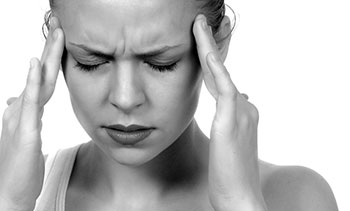
Most of us will experience a headache at one time or another, but for millions of people they are much more than just a headache. For the 10 percent Americans who suffer from migraines — a type of headache that produces a severe, throbbing pain on one or both sides of the head,, dizziness, sensitivity to light and sound — they can be debilitating. Increasing your understanding of the kind of headaches you may have is an important step towards treating and possibly preventing them.
Tension-type headaches
Almost everyone at some point has experienced a tension-type headache. Headaches that occur once in awhile are referred to as: occasional headaches. Some people experience tension-type headaches almost daily, and therefore are considered to be chronic. Headache symptoms for tension-type headaches usually include pressure on both sides of the head and back of the neck. This pain is usually constant, not sharp or sporadic.
Hormone headaches
Hormone headaches are menstrual headaches that may start before your period or while you’re menstruating. Migraines are also often associated with menstruation, with symptoms including throbbing pain on one side of the head, nausea, with sensitivity to light, sound and touch.
Cluster headaches
Cluster headaches are experienced more often by men than women. They are extremely severe headaches that last between 30 and 45 minutes and a person can have several in one day. Cluster headaches usually come on with no warning and the pain is piercing. The pain is usually located on one side of the head, often around the eye. The headaches will recur over a period of time, almost always on the same side, and are followed by a headache-free period.
Migraines
Migraines are often put in a classified differently than headaches because of the intensity of the pain and the overwhelming effect they have on the body. For some people, migraine symptoms include auras that occur before the migraine fully hits. The auras can be visual (seeing spots) or they can cause motor or verbal disturbances. Most migraine sufferers do not have auras before their migraine hits. Migraine pain is piercing, most often one-sided. People suffering from migraine headaches can feel increased sensitivity to light and sound as well as nausea.
Prevention
Although headaches may still occur, there are certain things you can do to help prevent or limit the amount of headaches you suffer. A healthy diet, exercise, hydration, stress relieving activities and sleep are all great ways to help control your health.
Treatment
Most headaches can be treated with over the counter medication such as advil. One should also try to rest and close their eyes. Ice packs have also proven to help relieve tension felt by headache and migraine sufferers alike. If your headache symptoms change or worsen you may be experiencing migraines, rather than headaches. If this is the case your doctor may prescribe you prescription medication which will be more effective in relieving your symptoms.
Medications designed for headache and migraine relief can be divided into two groups: pain-relieving and preventive. Pain-relieving medications are taken once symptoms begin, whereas preventive medications are taken regularly in order to stop headaches before they begin.
Pain-Relieving Headache & Migraine Medication
NSAIDs (nonsteroidal anti-inflammatory drugs)
These medications work by blocking a chemical in the body that causes inflamed tissue to swell and signals the brain when there is pain. NSAIDs include ibuprofen (Advil) and naproxen (Aleve). Aspirin is another NSAID sometimes used in combination with acetaminophen and caffeine for headache relief.
Preventive Migraine Medication
People who have frequent or difficult-to-treat migraines may benefit from taking a preventive medication.
Anti-seizure medications
Topiramate (Topamax), divalproex sodium (Depakote), and gabapentin (Neurontin) were initially designed to prevent seizures, but have been found to help prevent migraines as well.